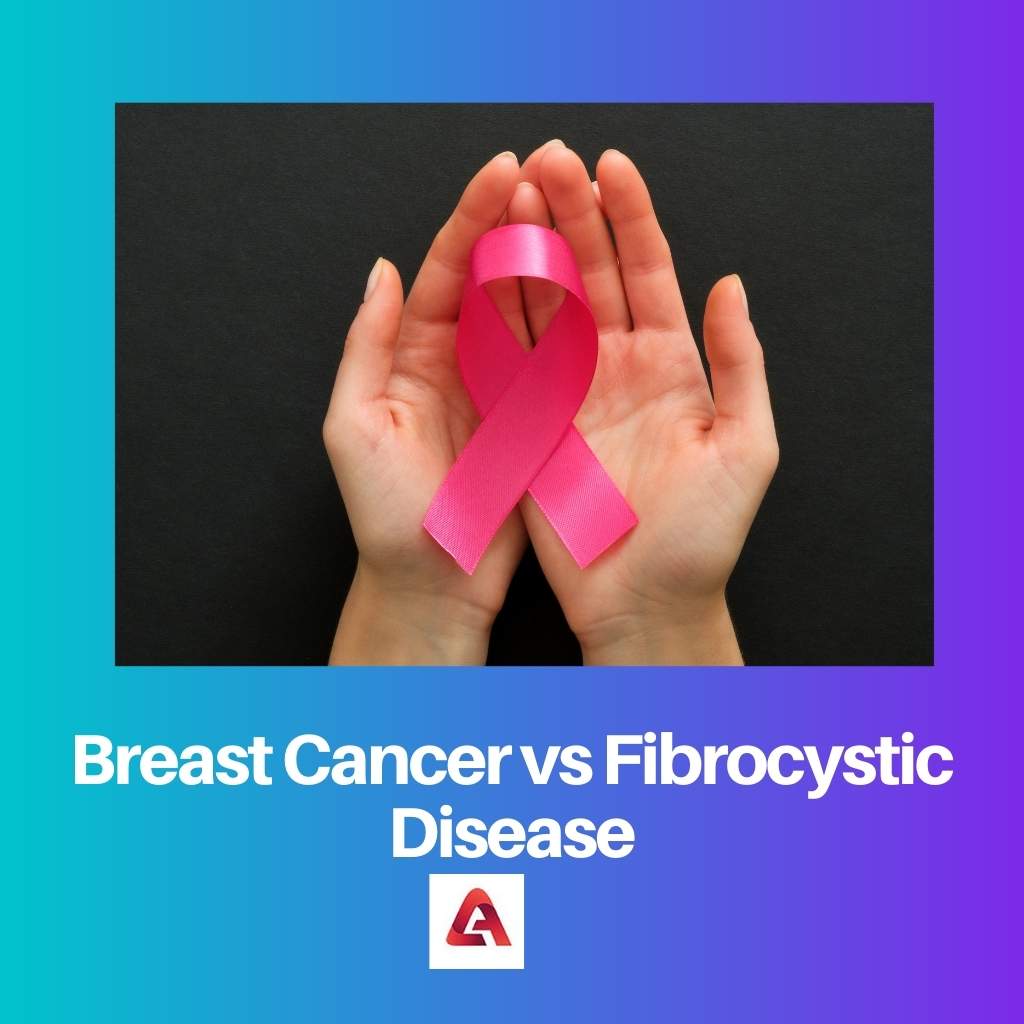Breast cancer and fibrocystic disease are both breast-related diseases. In Breast cancer, cells grow at a rapid rate; however, in fibrocystic disease, tissue forms lumps in the breasts.
Both of these diseases can occur in both men and women. Breast cancer is a more fatal disease than Fibrocystic disease.
Key Takeaways
- Breast cancer involves malignant cells growing uncontrollably, whereas fibrocystic disease consists of benign cysts and breast tissue changes.
- Symptoms of breast cancer include a lump, changes in breast size or shape, and nipple discharge, while fibrocystic disease manifests as breast pain, tenderness, and lumpiness.
- Treatment for breast cancer can include surgery, radiation, chemotherapy, and hormone therapy, while fibrocystic disease management involves pain relief and monitoring.
Breast Cancer vs Fibrocystic Disease
Fibrocystic disease is painful and affects one or both breasts, whereas Breast Cancer is painless and infiltrates the deeper tissues as well as the distant lymph nodes. Unlike Breast Cancer, Fibrocystic disease does not spread, grows slowly and reclines with a decline of hormonal levels.

Breast cancer is the most common type of cancer. It happens more in women around the ages of 15 to 50.
It is difficult to diagnose breast cancer at its very early stage however, technology is rising, and doctors are providing with best treatments they can.
Fibrocystic disease is also known as fibrocystic breasts or fibrocystic change. It doesn’t need many costly treatments. It forms lumps in the breasts.
Its symptoms are swelling, reddening of the skin, tightening lumps, etc. This disease doesn’t cause breast cancer, neither it risks the occurrence of breast cancer.
Comparison Table
| Parameters of Comparison | Breast Cancer | Fibrocystic disease |
|---|---|---|
| Definition | In breast cancer, the cells of the body grow uncontrollably in the breasts. | In fibrocystic disease, lumps are formed in the breasts. |
| Symptoms | Pain in the breast, Redness of skin, rashes, discharge from the nipple etc. | Breast pain, swelling, thickening of the lump with time, etc. |
| Treatment | Invasive treatments like chemotherapy, etc. | Regular painkillers or a small surgery, massage and, home remedies. |
| Death rate | 1 in 30 women can die due to breast cancer. The death rate is about 2.6 %. | This disease is not deadly. So the death rate is 0. |
| Cost | Around Rs. 5-6 lakh to 20 lakhs and more. | Rs. 300 to 2000. |
What is Breast Cancer?
Breast cancer, as the name suggests, is cancer that forms in the breast cells. Breast cancer is the most diagnosed cancer in women after skin cancer and lung cancer.
It can occur in men as well, but the chances of breast cancer in women are more.
In cancer, the cells of the body grow uncontrollably in one part of the body. These growing cells can outgrow other parts of the body as well at a rapid speed.
These cells are abnormal cells that are harmful to the body.
Breast cancer has many types. The most common type is Ductal carcinoma, in which cancer begins in the duct that carries the milk to the nipple.
Another one is Lobular cancer which begins in the gland that makes milk.
Pain in the breast, Redness of skin, rashes, or a discharge from the nipple are some of the symptoms of breast cancer. Even a lump can be formed as well, although not every lump is cancerous, one should get regular check-ups.
An early diagnosis of breast cancer can be treated, and the person can survive. It is very hard to save someone who is diagnosed in a late stage of cancer.

What is Fibrocystic Disease?
Fibrocystic Disease is not cancer. It also happens in breasts. In this disease, breasts are composed of tissues that cause breasts to feel lumpy.
They form a ropelike texture. This tissue is known as nodular or glandular breast tissue.
This disease doesn’t lead to breast cancer. It’s just lumps formed in the breast of the women because of changes in hormones.
It is not as harmful as breast cancer, but it can be uncomfortable and painful for women. The symptoms are breast pain, swelling, thickening of the lump with time, etc.
Fibrocystic disease doesn’t increase the risk of breast cancer in women; however, it can make it difficult to diagnose breast cancer in the patient.
The cause of this disease is not yet known exactly. Reproductive hormones like estrogen can be a cause.
Women from their 20s to 50s can get this disease. Doctors suggest that after menopause is not likely to have the disease.
Fibrocystic disease patients don’t need invasive treatment. Some regular painkillers and home treatments can be used for relief.
A mammogram, ultrasound, or MRI are some of the tests which will tell accurate details about fibrocystic breasts. A biopsy has mostly used the process of removing the fluid or tissue using a small needle.

Main Differences Between Breast Cancer And Fibrocystic Disease
- Breast cancer is cancer in which abnormal cells grow at a rapid speed. While fibrocystic disease is not cancer, it is a form of lumps in the breast.
- Breast cancer is harmful and can lead to death. Fibrocystic diseases are not harmful and can be treated. However, fibrocystic disease can make it difficult to diagnose breast cancer.
- Breast cancer requires invasive treatment, while fibrocystic disease can be treated with regular treatment and home remedies.
- Breast cancer treatment requires the most experience and it costs a lot as well. The fibrocystic breast doesn’t cost a lot.
- Breast cancer can spread to other parts of the body, making it more lethal. Fibrocystic disease doesn’t spread to other parts of the body.

- https://www.sciencedirect.com/science/article/pii/0022399984900382
- https://academic.oup.com/jnci/article-abstract/61/4/1055/952502

Understanding the biological and physiological differences between breast cancer and fibrocystic disease informs the approach to patient care and support.
The distinction between the two diseases, their symptoms, and the impact on patients’ lives highlights the need for continued research and medical advancements.
Medical research and development must prioritize the improvement of diagnostic methods and treatment options for these conditions.
Research into less invasive and more cost-effective treatments for breast cancer and fibrocystic disease is a critical area of focus.
The distinction between breast cancer and fibrocystic disease emphasizes the importance of accurate diagnosis and tailored treatment plans for patients.
Individualized treatment strategies based on the specific disease and patient characteristics are crucial for optimizing outcomes.
The treatment options available for breast cancer and fibrocystic disease are quite different and are determined based on the specific diagnosis.
Raising awareness about the risks associated with breast cancer and fibrocystic disease can help individuals recognize symptoms and seek early medical attention when necessary.
Empowering individuals with knowledge about these diseases is essential for promoting proactive health behavior and prompt treatment seeking.
The impact of reproductive hormones on the development of fibrocystic disease underscores the need for comprehensive research into the underlying mechanisms and risk factors.
Investigating the hormonal influences on fibrocystic disease can provide insights for targeted prevention and management strategies.
It’s important to know the difference between breast cancer and fibrocystic disease to understand how they affect the body.
Understanding the symptoms and how they manifest in the body is crucial to determine the right course of action.
The cost and invasive nature of treatments for breast cancer are significant factors that need to be considered in healthcare planning.
The cost of treatment can be a barrier to access for many individuals, which is a concerning issue.
Considering the financial burden of breast cancer treatment, access to affordable healthcare is essential.
The availability of non-invasive and cost-effective treatment options for fibrocystic disease highlights the importance of personalized healthcare planning and access to diverse medical interventions.
Equitable access to a range of healthcare services ensures that patients with fibrocystic disease can receive comprehensive and suitable treatment.
Tailoring healthcare services to individual patient needs and optimizing treatment affordability is a priority for healthcare systems.
Early diagnosis is key to successful treatment of breast cancer, which is why awareness of the symptoms is so important.